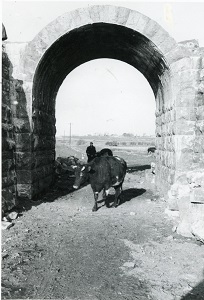THE DYKE ROAD

by Tom Kenny
The Dyke Road was originally known as ‘The Terryland Embankment’. In 1847, a group known as The Corrib Development Company applied for compensation claiming they had spent a considerable sum constructing the embankment --- at the time the river was very prone to serious flooding. The Commissioner for Public Works took over possession of the works after giving evidence in reply to the claim for compensation. They pointed out that the embankment was partially built in 1839, but after the water had risen that winter, it had given way. The Company carried out more works of reconstruction in 1840, but the flood waters burst it again. The river would flood on each occasion as far as Castlegar. The embankment was left unfinished until 1845 when the Company tried once more but failed to retain the river. They were subsequently compensated. The building of the canal a few years later greatly alleviated the flooding problems.
“The Menlo Line” was the name given to a proposed tramway to Oughterard and Clifden. The line would start at the Railway Terminus, pass over the Terryland River, Jordan’s Island, Terryland, Coolough and Menlo, then cross the river at the Friar’s Cut. The first station would be at Menlo and then a station every two miles. It was to be a steam railway, not a tramway. An iron swivel bridge was to be placed over the Friar’s Cut, 150 feet long with a ‘small portion of 30 feet wide to permit hookers and the steamer to pass’.
In 1884, the plas were altered and The Midland and Great Western Railway of Ireland Company were granted permission to construct the Clifden Railway (as we know it) but it was to cross the river just above the Salmon Weir. To erect the pillars in the river, they had to apply to the Corrib Navigation Trustees who agreed on condition that a drawbridge be provided to allow steamers to pass and provided the railway Company constructed what we know today as ‘Steamer’s Quay’.
There were 7 stations on the line and 28 bridges. The Corrib viaduct comprised three spans of 150 feet and a lifting span of 21 feet. The pier or pillar in the east side of the river was built inside a timber cofferdam and the foundations are of concrete 4 to 1 with masonry footings on boulder clay.
This pillar was about 60 yards west of the railway bridge over the entrance to the Dyke Road from Woodquay, which is our photograph today. This would have been the main road to Menlo from the town. The Railway Line opened on New Year’s Day 1895, but by the 1930’s it was in bad repair and doomed to closure. It finally closed in 1935, and this photograph was taken shortly afterwards
Most of the above information was taken from various books by Maurice Semple.
